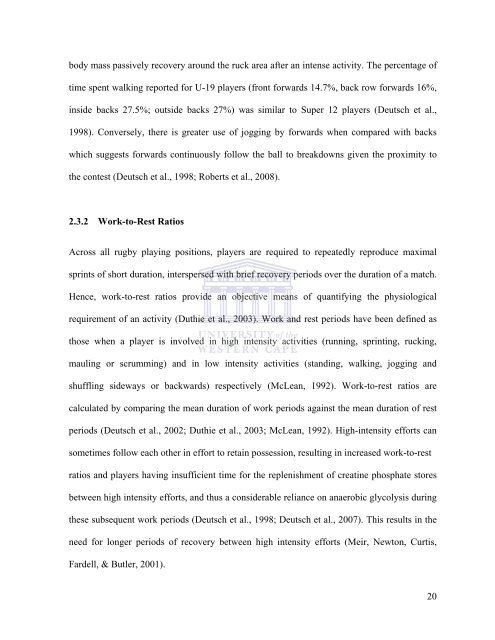Physical fitness of elite women's rugby union players over a ...
Physical fitness of elite women's rugby union players over a ...
Physical fitness of elite women's rugby union players over a ...
You also want an ePaper? Increase the reach of your titles
YUMPU automatically turns print PDFs into web optimized ePapers that Google loves.
ody mass passively rec<strong>over</strong>y around the ruck area after an intense activity. The percentage <strong>of</strong><br />
time spent walking reported for U-19 <strong>players</strong> (front forwards 14.7%, back row forwards 16%,<br />
inside backs 27.5%; outside backs 27%) was similar to Super 12 <strong>players</strong> (Deutsch et al.,<br />
1998). Conversely, there is greater use <strong>of</strong> jogging by forwards when compared with backs<br />
which suggests forwards continuously follow the ball to breakdowns given the proximity to<br />
the contest (Deutsch et al., 1998; Roberts et al., 2008).<br />
2.3.2 Work-to-Rest Ratios<br />
Across all <strong>rugby</strong> playing positions, <strong>players</strong> are required to repeatedly reproduce maximal<br />
sprints <strong>of</strong> short duration, interspersed with brief rec<strong>over</strong>y periods <strong>over</strong> the duration <strong>of</strong> a match.<br />
Hence, work-to-rest ratios provide an objective means <strong>of</strong> quantifying the physiological<br />
requirement <strong>of</strong> an activity (Duthie et al., 2003). Work and rest periods have been defined as<br />
those when a player is involved in high intensity activities (running, sprinting, rucking,<br />
mauling or scrumming) and in low intensity activities (standing, walking, jogging and<br />
shuffling sideways or backwards) respectively (McLean, 1992). Work-to-rest ratios are<br />
calculated by comparing the mean duration <strong>of</strong> work periods against the mean duration <strong>of</strong> rest<br />
periods (Deutsch et al., 2002; Duthie et al., 2003; McLean, 1992). High-intensity efforts can<br />
sometimes follow each other in effort to retain possession, resulting in increased work-to-rest<br />
ratios and <strong>players</strong> having insufficient time for the replenishment <strong>of</strong> creatine phosphate stores<br />
between high intensity efforts, and thus a considerable reliance on anaerobic glycolysis during<br />
these subsequent work periods (Deutsch et al., 1998; Deutsch et al., 2007). This results in the<br />
need for longer periods <strong>of</strong> rec<strong>over</strong>y between high intensity efforts (Meir, Newton, Curtis,<br />
Fardell, & Butler, 2001).<br />
20
















